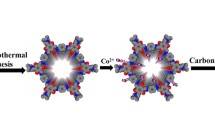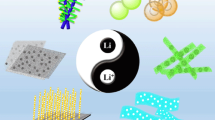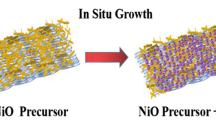Abstract
Cobalt-based oxygenic compounds Co(OH)2, CoO and Co3O4 are attractive for electrochemical energy storage owing to their high theoretical capacities and pseudocapacitive properties. Despite the great efforts to their compositional and morphological regulations, the performances to date are still quite limited owing to the low active surface area and sluggish charge transfer kinetics. Herein, different Co-based nanocrystals (Co-NCs) were conveniently anchored on the hierarchical nitrogen-doped carbon nanocages (hNCNCs) with high specific surface area and coexisting micro-meso-macropores to decrease the size and facilitate the charge transfer. Accordingly, a high specific capacity of 1170 F g−1 is achieved at 2 A g−1 for the Co(OH)2/hNCNCs hybrid, in which the capacitance of Co(OH)2 (2214 \({\rm{F\;g}}_{\rm{Co({OH})_2}}^{ - 1}\)) is approaching to its theoretical maximum (2595 F g−1), demonstrating the high utilization of active materials by the hybridization with N-doped nanocarbons. This study also reveals that these Co-NCs store/release electrical energy via the same reversible redox reaction despite their different pristine compositions. This insight on the energy storage of Co-based nanomaterials suggests that the commonly-employed transformation of the Co-NCs from Co(OH)2 to CoO and Co3O4 on carbon supports is unnecessary and even could be harmful to the energy storage performance. The result is instructive to develop high-energy-density electrodes from transition metal compounds.
摘要
Co(OH)2、CoO和Co3O4等钴基化合物因具有高理论容量和 赝电容性质而备受关注. 但受限于活性表面积小、电荷传输缓慢, 钴基纳米材料的实际储能性能却有限. 本文以我们前期开发的具 有大比表面积、高导电性和微孔-介孔-大孔共存的分级结构氮掺 杂碳纳米笼(hNCNCs)为载体, 成功构建了晶粒尺寸小、电荷转移 快的系列钴基纳米晶-hNCNCs复合材料, 有效地提高了活性材料 的利用率. 其中, Co(OH)2/hNCNCs在2 A g−1下表现出1170 F g−1的 高比容量, 基于活性物种Co(OH)2的比电容高达2214 F g−1, 接近其 理论值(2595 F g−1). 研究发现, 具有不同组成的Co(OH)2、CoO和 Co3O4纳米晶通过相同的可逆氧化还原反应存储/释放电能. 这种新 的储能机理表明将碳基载体上的Co(OH)2转化为CoO或Co3O4的策 略是提升储能性能的非必要条件, 还可能损害其储能性能. 本研究 可为开发过渡金属化合物基高能量密度电极材料提供借鉴.
Similar content being viewed by others
References
Winter M, Brodd RJ. What are batteries, fuel cells, and supercapacitors? Chem Rev, 2004, 104: 4245–4270
Goodenough JB. Evolution of strategies for modern rechargeable batteries. Acc Chem Res, 2013, 46: 1053–1061
Wang G, Zhang L, Zhang J. A review of electrode materials for electrochemical supercapacitors. Chem Soc Rev, 2012, 41: 797–828
Lai H, Wu Q, Zhao J, et al. Mesostructured NiO/Ni composites for high-performance electrochemical energy storage. Energy Environ Sci, 2016, 9: 2053–2060
Cheng F, Liang J, Tao Z, et al. Functional materials for rechargeable batteries. Adv Mater, 2011, 23: 1695–1715
Wang J, Dong S, Ding B, et al. Pseudocapacitive materials for electrochemical capacitors: from rational synthesis to capacitance optimization. Nat Sci Rev, 2016, 7: nww072
Chen X, Paul R, Dai L. Carbon-based supercapacitors for efficient energy storage. Natl Sci Rev, 2017, 4: 453–489
Jiang H, Lee PS, Li C. 3D carbon based nanostructures for advanced supercapacitors. Energy Environ Sci, 2013, 6: 41–53
Conway BE. Electrochemical Supercapacitors: Scientific Fundamentals and Technological Applications. New York: Kluwer Academic/Plenum Publishers, 1999
Simon P, Gogotsi Y, Dunn B. Where do batteries end and supercapacitors begin? Science, 2014, 343: 1210–1211
Augustyn V, Simon P, Dunn B. Pseudocapacitive oxide materials for high-rate electrochemical energy storage. Energy Environ Sci, 2014, 7: 1597–1614
Zhu YG, Wang Y, Shi Y, et al. CoO nanoflowers woven by CNT network for high energy density flexible micro-supercapacitor. Nano Energy, 2014, 3: 46–54
Jagadale AD, Jamadade VS, Pusawale SN, et al. Effect of scan rate on the morphology of potentiodynamically deposited β-Co(OH)2 and corresponding supercapacitive performance. Electrochim Acta, 2012, 78: 92–97
Wang R, Yan X, Lang J, et al. A hybrid supercapacitor based on flower-like Co(OH)2 and urchin-like VN electrode materials. J Mater Chem A, 2014, 2: 12724–12732
Salunkhe RR, Tang J, Kamachi Y, et al. Asymmetric supercapacitors using 3D nanoporous carbon and cobalt oxide electrodes synthesized from a single metal-organic framework. ACS Nano, 2015, 9: 6288–6296
Zhao T, Jiang H, Ma J. Surfactant-assisted electrochemical deposition of α-cobalt hydroxide for supercapacitors. J Power Sources, 2011, 196: 860–864
Yang S, Liu Y, Hao Y, et al. Oxygen-vacancy abundant ultrafine Co3O4/graphene composites for high-rate supercapacitor electrodes. Adv Sci, 2018, 5: 1700659
Xia X, Tu J, Zhang Y, et al. Freestanding Co3O4 nanowire array for high performance supercapacitors. RSC Adv, 2012, 2: 1835–1841
Mei J, Fu W, Zhang Z, et al. Vertically-aligned Co3O4 nanowires interconnected with Co(OH)2 nanosheets as supercapacitor electrode. Energy, 2017, 139: 1153–1158
Xiang K, Xu Z, Qu T, et al. Two dimensional oxygen-vacancy-rich Co3O4 nanosheets with excellent supercapacitor performances. Chem Commun, 2017, 53: 12410–12413
Zhou C, Zhang Y, Li Y, et al. Construction of high-capacitance 3D CoO@polypyrrole nanowire array electrode for aqueous asymmetric supercapacitor. Nano Lett, 2013, 13: 2078–2085
Wang Z, Liu Y, Gao C, et al. A porous Co(OH)2 material derived from a MOF template and its superior energy storage performance for supercapacitors. J Mater Chem A, 2015, 3: 20658–20663
Pang H, Li X, Zhao Q, et al. One-pot synthesis of heterogeneous Co3O4-nanocube/Co(OH)2-nanosheet hybrids for high-performance flexible asymmetric all-solid-state supercapacitors. Nano Energy, 2017, 35: 138–145
Jing M, Yang Y, Zhu Y, et al. An asymmetric ultracapacitors utilizing α-Co(OH)2/Co3O4 flakes assisted by electrochemically alternating voltage. Electrochim Acta, 2014, 141: 234–240
Xue T, Wang X, Lee JM. Dual-template synthesis of Co(OH)2 with mesoporous nanowire structure and its application in supercapacitor. J Power Sources, 2012, 201: 382–386
Zheng C, Cao C, Ali Z, et al. Enhanced electrochemical performance of ball milled CoO for supercapacitor applications. J Mater Chem A, 2014, 2: 16467–16473
Zhou Y, Zou X, Zhao Z, et al. CoO/rGO composite prepared by a facile direct-flame approach for high-power supercapacitors. Ceramics Int, 2018, 44: 16900–16907
Patil UM, Nam MS, Sohn JS, et al. Controlled electrochemical growth of Co(OH)2 flakes on 3D multilayered graphene foam for high performance supercapacitors. J Mater Chem A, 2014, 2: 19075–19083
Jiang J, Liu J, Ding R, et al. Large-scale uniform a-Co(OH)2 long nanowire arrays grown on graphite as pseudocapacitor electrodes. ACS Appl Mater Interfaces, 2011, 3: 99–103
Zhang F, Yuan C, Zhu J, et al. Flexible films derived from electrospun carbon nanofibers incorporated with Co3O4 hollow nanoparticles as self-supported electrodes for electrochemical capacitors. Adv Funct Mater, 2013, 23: 3909–3915
Wang H, Qing C, Guo J, et al. Highly conductive carbon-CoO hybrid nanostructure arrays with enhanced electrochemical performance for asymmetric supercapacitors. J Mater Chem A, 2014, 2: 11776–11783
Zhang F, Yuan C, Lu X, et al. Facile growth of mesoporous Co3O4 nanowire arrays on Ni foam for high performance electrochemical capacitors. J Power Sources, 2012, 203: 250–256
Gao Y, Chen S, Cao D, et al. Electrochemical capacitance of Co3O4 nanowire arrays supported on nickel foam. J Power Sources, 2010, 195: 1757–1760
Patil UM, Lee SC, Sohn JS, et al. Enhanced symmetric supercapacitive performance of Co(OH)2 nanorods decorated conducting porous graphene foam electrodes. Electrochim Acta, 2014, 129: 334–342
Yang W, Qu G, Chen M, et al. Effective NaBH4-exfoliated ultrathin multilayer Co(OH)2 nanosheets arrays and sulfidation for energy storage. Nanotechnology, 2018, 29: 295403
Wu Q, Yang L, Wang X, et al. From carbon-based nanotubes to nanocages for advanced energy conversion and storage. Acc Chem Res, 2017, 50: 435–444
Feng H, Ma J, Hu Z. Nitrogen-doped carbon nanotubes functionalized by transition metal atoms: A density functional study. J Mater Chem, 2010, 20: 1702–1708
Zhang Z, Chen Y, Zhou L, et al. The simplest construction of single-site catalysts by the synergism of micropore trapping and nitrogen anchoring. Nat Commun, 2019, 10: 1657
Zhao J, Lai H, Lyu Z, et al. Hydrophilic hierarchical nitrogen-doped carbon nanocages for ultrahigh supercapacitive performance. Adv Mater, 2015, 27: 3541–3545
Pralong V, Delahaye-Vidal A, Beaudoin B, et al. Oxidation mechanism of cobalt hydroxide to cobalt oxyhydroxide. J Mater Chem, 1999, 9: 955–960
Chen S, Wang L, Wu Q, et al. Advanced non-precious electrocatalyst of the mixed valence CoOx nanocrystals supported on N-doped carbon nanocages for oxygen reduction. Sci China Chem, 2015, 58: 180–186
Zhang Z, Wu Q, Mao K, et al. Efficient ternary synergism of platinum/tin oxide/nitrogen-doped carbon leading to high-performance ethanol oxidation. ACS Catal, 2018, 8: 8477–8483
Oktaviano HS, Yamada K, Waki K. Nano-drilled multiwalled carbon nanotubes: Characterizations and application for LIB anode materials. J Mater Chem, 2012, 22: 25167–25173
Li Z, Duan H, Shao M, et al. Ordered-vacancy-induced cation intercalation into layered double hydroxides: A general approach for high-performance supercapacitors. Chem, 2018, 4: 2168–2179
Zou Y, Kinloch IA, Dryfe RAW. Mesoporous vertical Co3O4 nanosheet arrays on nitrogen-doped graphene foam with enhanced charge-storage performance. ACS Appl Mater Interfaces, 2015, 7: 22831–22838
Lee KK, Chin WS, Sow CH. Cobalt-based compounds and composites as electrode materials for high-performance electrochemical capacitors. J Mater Chem A, 2014, 2: 17212–17248
Acknowledgements
This work was jointly supported by the National Key Research and Development Program of China (2017YFA0206500 and 2018YFA0209103), the National Natural Science Foundation of China (21832003, 21773111, 51571110 and 21573107), and the Fundamental Research Funds for the Central Universities (020514380126).
Author information
Authors and Affiliations
Contributions
Author contributions Wu Q and Hu Z conceived and supervised the project; Ma Q performed the experiments; Yao Y, Yan M, Zhao J, Ge C and Wang X helped to characterize the samples; Ma Q, Wu Q and Hu Z analyzed the data and wrote the paper with support from Yang L and Wang X. All authors contributed to the general discussion.
Corresponding authors
Additional information
Conflict of interest The authors declare no conflict of interest.
Qingming Ma received his Bachelor degree from the School of Chemistry and Chemical Engineering, Inner Mongolia University in 2016. He is currently a Master candidate in the School of Chemistry and Chemical Engineering, Nanjing University. His current research interest is the design of high-performance electrode nanomaterials for energy storage.
Qiang Wu obtained his BSc (1999) and PhD (2004) degrees in chemistry from Nanjing University. He was appointed an associate professor in 2006, and a professor at Nanjing University in 2015. As a Hua-Ying Scholar, he worked at Stanford University for one year. His scientific interest focuses on the rational design of nano-/ mesostructured materials and their applications in energy storage and conversion.
Zheng Hu received his BSc (1985) and PhD (1991) degrees in physics from Nanjing University. He became an associate professor of chemistry in 1993, and acquired the professor position in 1999, and Cheung Kong Scholar professor in 2007. He was awarded the National Natural Science Foundation of China for Outstanding Young Scientists (2005). He is engaged in the research of physical chemistry and materials chemistry addressing the growth mechanism, materials design and energy applications of a range of nano-/mesostructured materials, especially carbon-based materials, group III nitrides and transition metal oxides.
Electronic supplementary material
40843_2019_9449_MOESM1_ESM.pdf
Effective enhancement of electrochemical energy storage of cobalt-based nanocrystals by hybridization with nitrogen-doped carbon nanocages
Rights and permissions
About this article
Cite this article
Ma, Q., Yao, Y., Yan, M. et al. Effective enhancement of electrochemical energy storage of cobalt-based nanocrystals by hybridization with nitrogen-doped carbon nanocages. Sci. China Mater. 62, 1393–1402 (2019). https://doi.org/10.1007/s40843-019-9449-0
Received:
Accepted:
Published:
Issue Date:
DOI: https://doi.org/10.1007/s40843-019-9449-0




